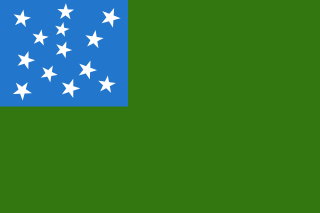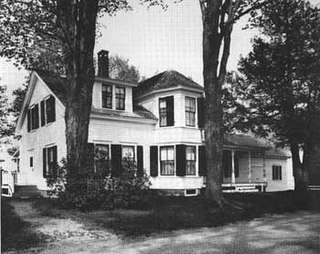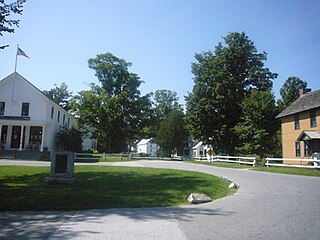
The Green Mountain Boys were a militia organization established in 1770 in the territory between the British provinces of New York and New Hampshire, known as the New Hampshire Grants and later in 1777 as the Vermont Republic. Headed by Ethan Allen and members of his extended family, it was instrumental in resisting New York's attempts to control the territory, over which it had won de jure control in a territorial dispute with New Hampshire.

The Battle of Bennington was a battle of the American Revolutionary War, part of the Saratoga campaign, that took place on August 16, 1777, on a farm in Walloomsac, New York, about 10 miles (16 km) from its namesake, Bennington, Vermont. A rebel force of 2,000 men, primarily New Hampshire and Massachusetts militiamen, led by General John Stark, and reinforced by Vermont militiamen led by Colonel Seth Warner and members of the Green Mountain Boys, decisively defeated a detachment of General John Burgoyne's army led by Lieutenant Colonel Friedrich Baum, and supported by additional men under Lieutenant Colonel Heinrich von Breymann.

Castleton is a town in Rutland County, Vermont, United States. Castleton is about 15 miles (24 km) to the west of Rutland, the county's seat and most populous city, and about 7 miles (11 km) east of the New York/Vermont state border. The town had a population of 4,458 at the 2020 census. A campus of Vermont State University is located there, with roots dating to 1787.
The Battle of Hubbardton was an engagement in the Saratoga campaign of the American Revolutionary War fought in the village of Hubbardton, Vermont. Vermont was then a disputed territory sometimes called the New Hampshire Grants, claimed by New York, New Hampshire, and the newly organized, not yet recognized, but de facto independent government of Vermont. On the morning of July 7, 1777, British forces, under General Simon Fraser, caught up with the American rear guard of the forces retreating after the withdrawal from Fort Ticonderoga. It was the only battle in Vermont during the revolution.

Seth Warner was an American soldier. He was a Revolutionary War officer from Vermont who rose to the rank of Continental colonel and was often given the duties of a brigade commander. He is best known for his leadership in the capture of Fort Crown Point, the Battle of Longueuil, the siege of Quebec, the retreat from Canada, and the battles of Hubbardton and Bennington.

The Coolidge Homestead, also known as Calvin Coolidge Homestead District or President Calvin Coolidge State Historic Site, was the childhood home of the 30th president of the United States, Calvin Coolidge and the place where he first took the presidential oath of office. Located in Plymouth Notch, Vermont, Coolidge lived there from age four in 1876 to 1887, when he departed for Black River Academy for education. He is buried in Plymouth Notch Cemetery not far from the home.

The Brave Little State of Vermont speech is a name given to remarks delivered by Vermont native and U.S. President Calvin Coolidge at Bennington on September 21, 1928. Coolidge was touring his home state by train to assess progress of recovery following the devastating 1927 flood. Considered taciturn and nicknamed "Silent Cal," Coolidge demonstrated unusual emotion in delivering his extemporaneous response to the human suffering and loss he had witnessed.

Mount Independence on Lake Champlain in Orwell, Vermont, was the site of extensive fortifications built during the American Revolutionary War by the American army to stop a British invasion. Construction began in July 1776, following the American defeat in Canada, and continued through the winter and spring of 1777. After the American retreat on July 5 and 6, 1777, British and Hessian troops occupied Mount Independence until November 1777.

The Justin Smith Morrill Homestead is the historic Carpenter Gothic home of United States Senator Justin Smith Morrill (1810–98) in Strafford, Vermont, and was one of the first declared National Historic Landmarks, in 1960. It is located at 214 Justin Morrill Highway, south of the village green of Strafford. The homestead is a Vermont State Historic Site owned by the Vermont Division for Historic Preservation, a state agency, and is open for tours from May to October.

Vermont The following outline is provided as an overview of and topical guide to the U.S. state of Vermont:

The President Chester A. Arthur State Historic Site is a state historic site located in Fairfield, Vermont. It honors Chester A. Arthur, the 21st president of the United States, who was born in Vermont in 1829. The site includes a replica of the original early 19th-century home in which he was born that was constructed in 1953 using an old photograph of the house as a guide. In 1903, a granite monument was dedicated on the spot where it was thought he had been born.
Events from the year 1777 in the United States.

Coolidge State Park is a Vermont State Park located in Plymouth, Vermont, United States. The park is named after Calvin Coolidge, the 30th President of the United States, who was born and raised in Plymouth and is buried there as well. It is the primary recreational center for Calvin Coolidge State Forest, the largest state forest in Vermont. The park's facilities, built by the Civilian Conservation Corps (CCC) in the 1930s, are listed on the National Register of Historic Places.

John Calvin Coolidge Sr. was an American politician and businessman from Vermont, and the father of Calvin Coolidge, the 30th president of the United States. The senior Coolidge administered the presidential oath of office to his son at their family homestead in the early morning hours of August 3, 1923, following the death of President Warren G. Harding.
The military history of Vermont covers the military history of the American state of Vermont, as part of French colonial America; as part of Massachusetts, New Hampshire and New York during the British colonial period and during the French and Indian Wars; as the independent New Connecticut and later Vermont during the American Revolution; and as a state during the War of 1812 and the American Civil War.

The Governor Jonas Galusha Homestead is a historic homestead at 3871 Vermont Route 7A in Shaftsbury Center, Vermont. Built in 1783 and enlarged in 1805, it is a well-preserved example of Federal period architecture. It was built by Jonas Galusha, Vermont's fifth governor and a leading politician and military figure of southern Vermont for many years. It is now home to the Shaftsbury Historical Society, and was listed on the National Register of Historic Places in 1979.

The Plymouth Historic District encompasses the village environment and surrounding landscape of Plymouth Notch, Vermont, the birthplace and historic homestead of United States President Calvin Coolidge. It includes more than 2,000 acres (810 ha), including the entire bowl-shaped valley where the village is located. It was listed on the National Register of Historic Places in 1970. The village itself, now a Vermont state park, was designated a National Historic Landmark District in 1965.

The Vermont Sesquicentennial half dollar, sometimes called the Bennington–Vermont half dollar or the Battle of Bennington Sesquicentennial half dollar, is a commemorative fifty-cent piece struck by the United States Bureau of the Mint in 1927. The coin was designed by Charles Keck, and on its obverse depicts early Vermont leader Ira Allen, brother of Ethan Allen.
The Phoenix was a sidewheel paddle steamer operating on Lake Champlain between the United States states of New York and Vermont, and the British province of Lower Canada. Built in 1815, she grounded, burned and sank in 1819 off the shore of Colchester, Vermont. Her surviving wreckage is the oldest known example of a sidewheel steamer anywhere in the world. The wreck site is a Vermont State Historic Site, which may be visited by registered and qualified divers. It was listed on the National Register of Historic Places in 1998.
Albert W. Harvey was a Vermont businessman and government official. He served as Vermont’s U.S. Marshal from 1922 to 1935.